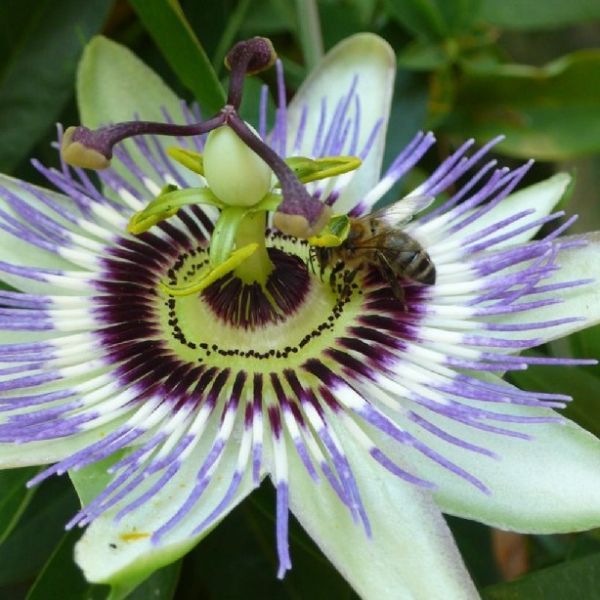Passiflora Caerulea Seeds (Blue Passion Flower Seeds)
Passiflora Caerulea Seeds (Blue Passion Flower Seeds)
Flowers are ornate, multi-colored, with a minty scent. This evergreen or semi-evergreen climber produces beautiful white and purple-blue flowers.

Delivery
All orders shipped with UPS Express.
Always free shipping for orders over US $250.
All orders are shipped with a UPS tracking number.
Returns
Items returned within 14 days of their original shipment date in same as new condition will be eligible for a full refund or store credit.
Refunds will be charged back to the original form of payment used for purchase.
Customer is responsible for shipping charges when making returns and shipping/handling fees of original purchase is non-refundable.
All sale items are final purchases.
Help
Give us a shout if you have any other questions and/or concerns.
Email: contact@domain.com
Phone: +1 (23) 456 789
Availability: In stock
SKU
Passiflora Caerulea
Passiflora caerulea, or the Blue Passion Flower is typically grown in tropical gardens or greenhouses for the exotic beauty of its flowers. Blue Passion Flower is native to Southern Brazil and Argentina. Wild range extends throughout Central and South America and as far North as the Southern United States. Extremely fast growing vine that may grow up to 30 feet tall. It grows on fences or trellises, or allow it to scramble over shrubs and trees. It an be kept as an container plant. It may be grown as a houseplant in a sunny South-facing window.
Passiflora caerulea flowers from Summer through Autumn. Flowers are ornate, multi-colored, with a minty scent. This evergreen or semi-evergreen climber produces beautiful white and purple-blue flowers, they may be as large as 4 inches across. In warmer climates without much frost, the vine will grow and bloom throughout the year.
This Passion Flower is producing egg shaped orange fruits with deep red edible pulp. They aren't very tasty raw, but they have a vaguely blackberry-like flavor. The shiny green leaves are usually palmately lobed with five parts, but they can have as few as three lobes or as many as nine. They are evergreen in Tropical climates, but deciduous where Winters are cool.
Pruning is a must to keep the vine healthy. Prune off less vigorous growth and occasionally prune back vigorous growth to promote flowering. When established, and without care, the passion fruit can easily overtake other garden plants, shading them from sun.
Hardiness zones 8-11, (-10øC/15øF, 4øC/40øF) in Winter. This is one of the hardiest Passion Flowers, dying back in colder climates but hardy to 10øF. Blue Passion Flowers will regrow from deep roots after even severe freezes. It is best suited to warm areas. Plant in rich, well-drained soil in full sun and provide support. The plant prefers a humid environment but will tolerate almost anything outside of desert conditions. Provide ideally a temperature of 15-28øC in Summer and 13-18øC through the Winter. It will do best in a loam based mix with a little peat moss. Likes light and evenly moist soil, mulch well.
You may need to water your plants on a daily basis during the hottest Summer months. During the Winter the roots should be kept moist, but as growth will be much slower you will probably only need to water once a week, depending on growing temperature. Fertilize at least once every two weeks in the growing season.
If their pot is too large or if they have an unrestricted root run then the whole plant will simply get bigger and bigger but it will refuse to flower and therefore produce the fruits. By limiting the pot size you are limiting the ability to grow and this is seen as a threat, so the natural mechanism is to produce seeds for the next generation. A suitably sized pot for an adult plant would generally be of 12 inches in diameter.
| Common name | Blue Passion Flower |
|---|---|
| Species | Passiflora caerulea |
| Germination | Soak seed in warm water for 24 hours before sowing, in a good seed compost at 1/4" deep. For Passiflora seeds, instead of using water you can use a high pulp fruit juice such as passion fruit juice or orange juice. The acid in these juices will soften the shell and speed up germination. Keep damp soil, not soaking wet. Keep pot in warm situation 20øC/68øF, 24øC/75øF. Cover the top of the pot with clear plastic so the humidity will remain high. When you see some tiny plants starting to sprout, slowly open the top of the pot, a little each day, so that the new seedlings don't go into shock from the humidity being lowered too quickly. Germination of Passiflora can occur in weeks or take several months. If you want to speed up germination, you can use the bottom heat technique, but it isn't a must. |
| Scarification / Stratification | If your home is on the low side of 70§F, your seeds will benefit from bottom heat. Give warmth from underneath to stimulate early growth, and to help seeds to germinate. The ideal situation is to maintain the soil temperature at 70§F. For this, you use an electric soil warming cable kit, or a heating mat that goes under your flats; or any other source of heat. With the proper temperature, you will cut by 2 or 3 the germination time. |
| Price View | Price Range |

